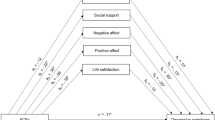Abstract
An imaginary companion (IC) is a frequently encountered childhood fantasy, invisible to anyone but the child, who may be named, addressed or played with. Whether the presence of an IC is a normal developmental feature has not been determined. We examined psychometric measures and the presence/absence of childhood IC in a sample of 850 mentally healthy adolescents. 17.6% of our subjects, more often females, reported having had such a companion. Subjects who reported having had an IC in childhood exhibited higher levels of distress and emotional discontrol, displayed prolonged transitional object attachment and immature modes of coping with stress. Thus, although childhood imaginary companionship is not indicative of psychopathology, it may denote a vulnerability for adolescent perturbation and difficulty in coping with emotionally laden situations.
Similar content being viewed by others
References
Svendsen M: Childrens' imaginary companions. Arch Neurol Psychiatry 12: 985–989, 1934.
Schaeffer CE: Imaginary companions and creative adolescents. Dev Psychol 1:747–749, 1969.
Sperling OE: An imaginary companion representing a pre-stage of the superego. Psychoanal Study Child 9:252–258, 1954.
Nagera, H: The imaginary companion: Its significance for ego development and conflict resolution. Psychoanal Study Child 24:165–195, 1969.
Klein BR: A child's imaginary companion: A transitional self. Clin Soc Work J 13(3):272–282, 1985.
Hurlock EB & Burnstein M: The imaginary playmate: A questionnaire study. J Genet Psychol, 41:380–392, 1932.
Munroe JP: Report at NEA meeting. Pediater Sem 3:182–184, 1894.
Vostrovsky C: A study of imaginary companions. Education 15: 393–398, 1895.
Pines M: Invisible playmates. Psychol Today, 106: 38–42, 1979.
Manosevitz M, Prentice NM, Wilson F: Individual and family correlates of imaginary companions in preschool children. Dev Psychol 8:72–79, 1973.
Somers JU, Yawkey TD: Imaginary play companions: Contributions of creative and intellectual abilities of young children. J Creat Behav 18(2):77–89, 1984.
Meyer JR, Tuber SB: Intrapsychic and behavioral correlates of the phenomenon of imaginary companions in young children. Psychoanal Psychol 6(2):151–168, 1989.
Singer JL: The Child's World of Make Belief. New York: Academic Press, 1973.
Myers WA: Imaginary companions in childhood and adult creativity. Pychoanal Q 48(2):292–307, 1979.
Myers WA: Imaginary companions, fantasy twins, mirror dreams and depersonalization. Pychoanal Q 45(4):503–524, 1976.
Parker G, Tupling H, Brown LB: A Parental Bonding Instrument. Br J Med Psychol 52:1–10, 1979.
Derogatis LR, Spencer PM: The Brief Symptom Inventory: Administration, scoring and procedures, Manual I. Baltimore, MD: Clinical Psychometric Research, 1982.
Dupuy DF: Utility of the National Center for Health Statistics' General Well Being Schedule in the assessment of self representations of subjective well being and distress. Paper presented at the National Conference on the Evaluation of Drug, Alcohol and Mental Health Programs, 1975.
Prociadno MF, Heller K: Measures of perceived social support from friends and from family. Three validation studies. Am J Comm Psychol 11(1): 1–23, 1983.
Free K, Goodrich W: Transitional object attachment in normal and in chronically disturbed adolescent population. Child Psychiat Hum Develpm 16(1): 30–44, 1985.
Bachar E, Canetti L, Galili-Weisstub E, Kaplan-DeNour A, Shalev AY: Childhood Vs. adolescence transitional object attachment, and its relation to mental health and parental bonding. Child Psychiat Hum Develpm 28(3): 411–420, 1996.
Sullivan HS: The Interpersonal Theory of Psychiatry. New York, Norton, 1953.
Ames LB, Learned J: Imaginary companions and related phenomena. J Genet Psychol 69: 147–167, 1946.
Benson RM: Narcissistic guardians: developmental apexes of transitional objects, imaginary companions, and career fantasies. Adolesc Psychiatry 8: 253–264, 1980.
Deri S: Transitional phenomena: Vicissitudes of symbolization and creativity. In: Between Reality and Fantasy: Transitional Objects and Phenomena, eds. S.A. Grolnick and L. Borkin, in collaboration with W. Muensterberger. New York: Jason Aronson, 1977.
Lasker M: Imaginary companions and transitional objects: Narcissistic guardians of children. Northampton: Smith College Studies in Social Work, 1977.
Winnicot DW: Transitional objects and transitional phenomena. Int J Psychoanal 34: 89–97, 1953.
Freud A: The Writings of Anna Freud: The ego and Mechanisms of Defense. Vol. 2, New York: International Universities Press, Inc., 1966.
Author information
Authors and Affiliations
Rights and permissions
About this article
Cite this article
Bonne, O., Canetti, L., Bachar, E. et al. Childhood Imaginary Companionship and Mental Health in Adolescence. Child Psychiatry Hum Dev 29, 277–286 (1999). https://doi.org/10.1023/A:1021345015520
Issue Date:
DOI: https://doi.org/10.1023/A:1021345015520




